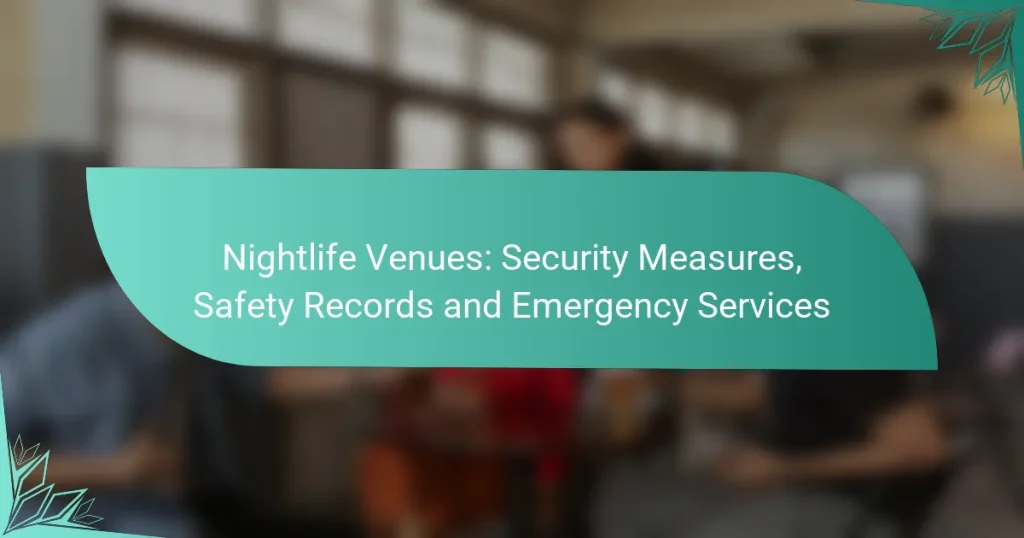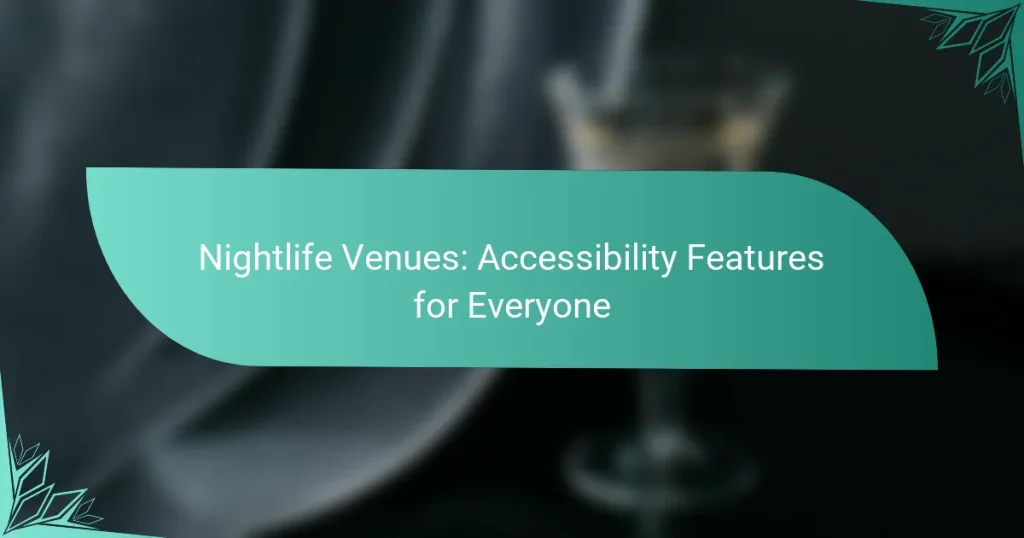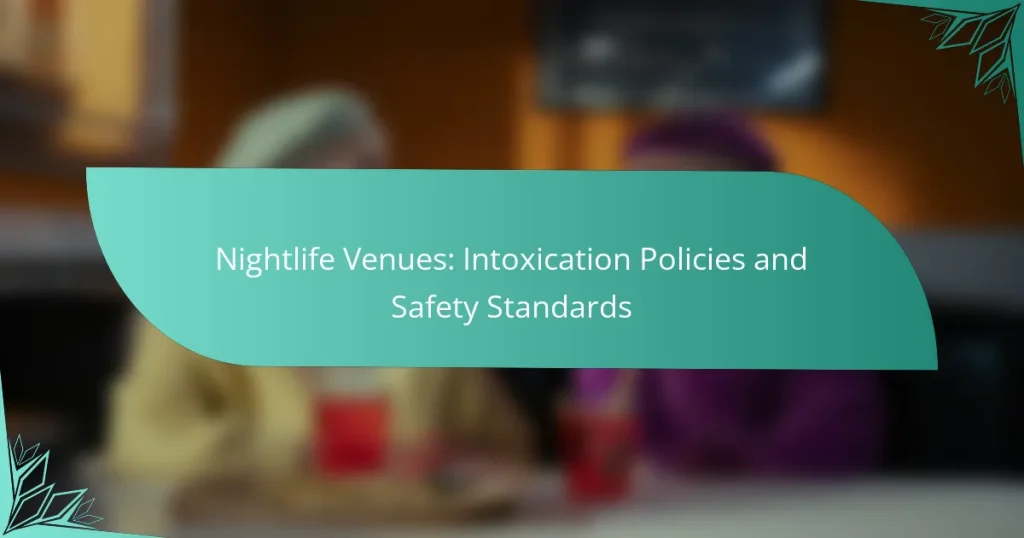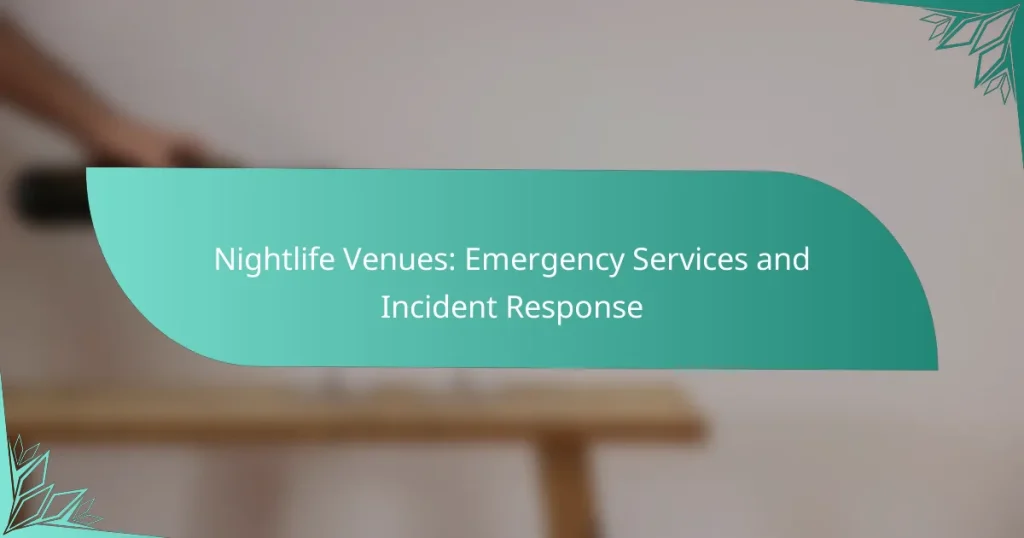Ensuring safety and accessibility in nightlife venues is crucial for creating an enjoyable experience for all patrons. By implementing effective security measures and adhering to legal requirements, venues can foster a secure environment while also accommodating individuals with disabilities. Key features such as wheelchair ramps and accessible restrooms are essential for inclusivity, allowing everyone to partake in the vibrant nightlife scene.
Nightlife Venues: Security Measures, Safety Records and Emergency Services
Nightlife Venues: Accessibility Features for Everyone
Nightlife Venues: Intoxication Policies and Safety Standards
Nightlife Venues: Safety Features, Security Measures and Accessibility
Nightlife Venues: Emergency Services and Incident Response
How can nightlife venues improve safety in Los Angeles?
Nightlife venues in Los Angeles can enhance safety by implementing a combination of security measures, staff training, and technology. These strategies not only protect patrons but also create a more secure environment that encourages responsible enjoyment of nightlife.
Enhanced security personnel
Employing well-trained security personnel is crucial for maintaining safety in nightlife venues. Security staff should be visible, approachable, and trained to handle various situations, from crowd control to conflict resolution. Venues might consider hiring off-duty police officers for added authority and expertise.
Regular training sessions can ensure that security personnel are updated on the latest safety protocols and emergency procedures. This preparation helps them respond effectively to incidents, ensuring a safer environment for all patrons.
Surveillance camera installations
Installing surveillance cameras throughout the venue can deter criminal activity and provide valuable evidence in case of incidents. Cameras should cover entrances, exits, and high-traffic areas to maximize their effectiveness. It’s essential to inform patrons about the presence of cameras to promote transparency and trust.
Venues should ensure that the camera system is regularly maintained and that footage is stored securely for a reasonable period. This practice allows for quick retrieval of evidence if needed, enhancing overall safety management.
Emergency response training
Training staff in emergency response is vital for effective crisis management in nightlife venues. This training should cover various scenarios, including medical emergencies, fire evacuations, and active shooter situations. Staff should know how to communicate clearly and efficiently during emergencies to guide patrons safely.
Regular drills can help reinforce these skills and ensure that all employees are familiar with emergency protocols. This preparedness can significantly reduce response times and improve outcomes during actual emergencies.
Incident reporting systems
Implementing an incident reporting system allows staff and patrons to report safety concerns or incidents easily. This can be a digital platform or a physical logbook where reports can be documented and reviewed. Quick access to this information helps management identify patterns and address issues proactively.
Encouraging a culture of reporting can empower patrons to speak up about unsafe situations, contributing to a safer nightlife environment. Venues should ensure that reports are handled confidentially to protect the identities of those involved.
Regular safety audits
Conducting regular safety audits helps nightlife venues assess their security measures and identify areas for improvement. These audits should evaluate physical security, staff training, and emergency preparedness. Engaging third-party safety consultants can provide an objective perspective on vulnerabilities.
Venues should establish a schedule for these audits, ideally every six months, to ensure ongoing compliance with safety standards. Addressing identified issues promptly can significantly enhance the overall safety of the venue.
What accessibility features should nightlife venues in New York offer?
Nightlife venues in New York should provide essential accessibility features to ensure all patrons can enjoy their experiences. Key elements include wheelchair ramps, accessible restrooms, appropriate seating arrangements, and options for sign language interpretation during events.
Wheelchair ramps and accessible entrances
Wheelchair ramps and accessible entrances are critical for ensuring that individuals with mobility challenges can enter and exit venues safely. Ramps should have a gentle slope, ideally not exceeding a 1:12 ratio, and entrances should be wide enough to accommodate wheelchairs and mobility devices.
Additionally, venues should ensure that doors are easy to open, ideally with automatic mechanisms or handles that require minimal effort. Clear signage indicating accessible entrances can further enhance usability.
Accessible restrooms
Accessible restrooms are a vital feature in nightlife venues, providing privacy and convenience for individuals with disabilities. These restrooms should be spacious enough to accommodate a wheelchair and include grab bars for support.
It is recommended that at least one accessible restroom be available for every 10 standard restrooms, ensuring ample access for all guests. Clear signage should direct patrons to these facilities, and they should be regularly maintained for cleanliness and functionality.
Seating arrangements for mobility devices
Seating arrangements must consider the needs of patrons using mobility devices, ensuring that there is adequate space for maneuverability. Venues should provide designated seating areas that are easily accessible and allow for comfortable positioning of wheelchairs or scooters.
Tables should be at an appropriate height for wheelchair users, and staff should be trained to assist with seating when necessary. It’s beneficial to have a mix of seating options, including tables and lounge areas, to accommodate diverse needs.
Sign language interpreters for events
Providing sign language interpreters at events is essential for ensuring that deaf and hard-of-hearing patrons can fully participate. Venues should consider hiring qualified interpreters for performances, announcements, and other interactive elements.
It is advisable to promote the availability of interpreters in advance, allowing attendees to plan accordingly. Venues can also explore technology options, such as captioning services, to enhance accessibility for all guests.
What are the legal requirements for safety and accessibility in nightlife venues?
Nightlife venues must adhere to various legal requirements for safety and accessibility to ensure a secure and inclusive environment for all patrons. These regulations often include compliance with the Americans with Disabilities Act (ADA), local safety codes, and necessary licensing for events.
ADA compliance standards
ADA compliance standards require nightlife venues to provide accessible facilities for individuals with disabilities. This includes features such as wheelchair ramps, accessible restrooms, and designated seating areas. Venues should regularly assess their compliance to avoid potential legal issues and enhance the experience for all guests.
To ensure compliance, venues can conduct audits using ADA checklists that cover aspects like parking accessibility, signage, and emergency exits. Investing in training staff on ADA requirements can also improve service and safety for patrons with disabilities.
Local safety regulations
Local safety regulations vary by city and state but generally include fire safety codes, occupancy limits, and health regulations. Nightlife venues must maintain clear emergency exit routes, conduct regular fire drills, and ensure that all safety equipment is functional. Failure to comply can result in fines or closure.
It is advisable for venue owners to stay updated on local regulations by consulting with local authorities or legal experts. Regular inspections and maintenance of safety equipment, such as fire extinguishers and alarms, are essential to meet these requirements.
Licensing and permits for events
Licensing and permits are crucial for hosting events in nightlife venues, as they ensure compliance with local laws regarding alcohol service, noise levels, and crowd control. Venues typically need to apply for a liquor license and may require special permits for live music or large gatherings. The application process can vary significantly by location.
Venue owners should familiarize themselves with the specific requirements in their area, including application timelines and fees. Keeping all licenses up to date and renewing them on time is essential to avoid interruptions in operations and potential legal penalties.
How do patrons perceive safety and accessibility in nightlife venues?
Patrons often perceive safety and accessibility in nightlife venues as critical factors influencing their overall experience. Concerns about personal safety, crowd management, and physical accessibility can significantly affect their willingness to visit and enjoy these spaces.
Surveys and feedback mechanisms
Surveys and feedback mechanisms are essential tools for understanding patrons’ perceptions of safety and accessibility. Venues can implement post-visit surveys, both online and in-person, to gather insights on patrons’ experiences. Questions may cover aspects like lighting, security presence, and accessibility features.
Offering incentives, such as discounts on future visits, can encourage patrons to provide honest feedback. Analyzing this data helps venues identify areas for improvement and prioritize changes that enhance safety and accessibility.
Social media sentiment analysis
Social media sentiment analysis allows venues to gauge public perception regarding safety and accessibility in real-time. By monitoring platforms like Twitter, Instagram, and Facebook, venues can track mentions and comments related to their safety measures and accessibility options.
Using tools to analyze sentiment can reveal trends and common concerns among patrons. This information can guide venues in addressing issues promptly and effectively, ensuring a safer and more accessible environment for all guests.
What are the best practices for training staff on safety and accessibility?
Effective training for staff on safety and accessibility involves comprehensive education on emergency procedures, disability awareness, and customer service skills. This ensures that employees are equipped to handle various situations while providing an inclusive environment for all patrons.
Regular workshops and seminars
Hosting regular workshops and seminars is crucial for keeping staff updated on the latest safety protocols and accessibility standards. These sessions can cover topics such as first aid, evacuation plans, and the specific needs of individuals with disabilities.
Consider scheduling these workshops quarterly, allowing staff to refresh their knowledge and learn about new practices. Engaging guest speakers or experts in accessibility can enhance the learning experience and provide valuable insights.
Collaboration with local advocacy groups
Partnering with local advocacy groups can significantly improve the training process by providing real-world perspectives and resources. These organizations often have expertise in accessibility and can offer tailored training sessions for staff.
Additionally, collaborating with advocacy groups can help venues stay informed about community needs and expectations. This relationship can foster a more inclusive atmosphere and encourage feedback on how to improve safety and accessibility measures.
How can nightlife venues in Chicago enhance emergency preparedness?
Nightlife venues in Chicago can enhance emergency preparedness by implementing structured plans, regular training, and clear communication strategies. These measures ensure staff are equipped to respond effectively during emergencies, ultimately safeguarding patrons and minimizing risks.
Regular emergency drills
Conducting regular emergency drills is essential for ensuring that staff are familiar with emergency protocols. These drills should simulate various scenarios, such as fire evacuations or active shooter situations, allowing employees to practice their responses in a controlled environment.
Venues should schedule these drills at least quarterly, adjusting the frequency based on the size and complexity of the venue. After each drill, a debriefing session can help identify areas for improvement and reinforce best practices.
Additionally, involving local emergency services in these drills can provide valuable insights and enhance coordination during actual emergencies. Establishing a clear communication plan with local authorities ensures that everyone knows their roles and responsibilities in a crisis.





